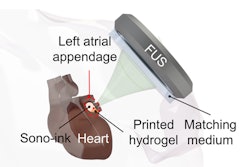Ultrasonic flow ratio is a reliable method for computing fractional flow reserve in assessing coronary stenosis, a study published January 9 in the International Journal of Cardiology found.
Researchers led by Cheng Yang from the Chinese Academy of Medical Sciences in Beijing found that this novel intravascular ultrasound (IVUS)-derived method has excellent concordance with fractional flow ratio, is non-inferior to quantitative flow reserve, and is superior to minimum lumen area.
“Ultrasonic flow ratio provides a potentiality for the integration of physiological assessment and intravascular imaging in clinical practice,” Yang and colleagues wrote.
IVUS offers a way to optimize percutaneous coronary intervention, with previous research demonstrating that it addresses the limitations of coronary angiography. The researchers added that IVUS has “exceptional” spatial resolution for clinicians to obtain a profile of the vessel wall.
Fractional flow reserve is the gold standard for assessing the functional significance of coronary stenosis. However, the researchers noted that its use is limited by the high costs of pressure wires, reimbursement challenges, longer procedure times, and the possible side effects from adenosine.
Ultrasonic flow ratio is a method derived from IVUS, using imaging data to quickly calculate fractional flow reserve. It does not use pressure wires or adenosine.
Yang and co-authors compared the diagnostic performance of ultrasonic flow ratio and quantitative flow ratio, using fractional flow reserve as the reference standard. They included data from 78 patients with intermediate coronary artery lesions who were referred to IVUS and fractional flow reserve measurements. This included a diameter stenosis of 30% to 90% by visual estimation.
The team analyzed 98 vessels with both fractional flow reserve, ultrasonic flow ratio, and quantitative flow ratio. It reported that the fractional flow reserve was 0.79. Ultrasonic flow ratio showed a strong correlation with fractional flow reserve, similar to quantitative flow ratio (r = 0.83 vs. 0.82, p = 0.795).
The researchers also found that ultrasonic flow ratio was overall non-inferior to quantitative flow ratio in identifying hemodynamically significant stenosis.
| Comparison between ultrasonic, quantitative flow ratio | |||
|---|---|---|---|
| Quantitative flow ratio | Ultrasonic flow ratio | p-value | |
| Diagnostic accuracy | 90% | 94% | 0.113 |
| Sensitivity | 85% | 89% | 0.453 |
| Specificity | 95% | 97% | 0.625 |
| Area under the curve (AUC) | 0.93 | 0.95 | 0.293 |
The researchers also found that the AUC of ultrasonic flow ratio (0.95) was significantly higher than that of minimum lumen area (0.82, p < 0.001). Additionally, ultrasonic flow ratio and quantitative flow ratio did not show significant differences in diagnostic accuracy when assessing bifurcation and nonbifurcation lesions.
The study authors highlighted that ultrasonic flow ratio addresses the limitations of quantitative flow ratio, including vessel overlapping, foreshortening, and interference with calcifications.
“Ultrasonic flow ratio provides superior physiological and morphological information beyond both invasive coronary angiography and simple functional examinations, using to percutaneous coronary intervention optimization throughout the procedure, whether pre-, during, or postprocedure,” they wrote.
The authors added that in the era of precision medicine, ultrasonic flow ratio could help guide revascularization strategies and optimize percutaneous coronary intervention results by combining coronary intravascular imaging and physiological evaluation without the need for additional invasive instruments.
The full study can be found here.



















